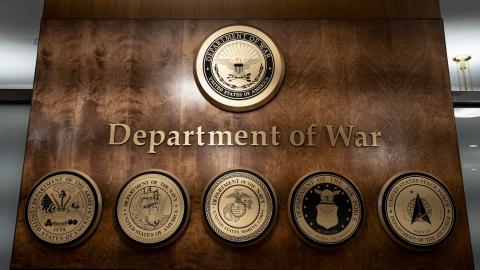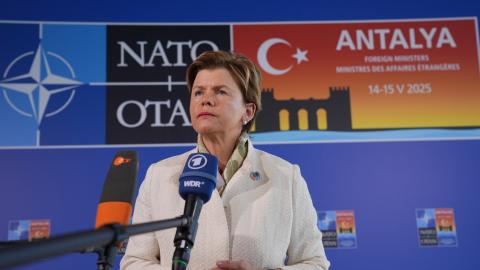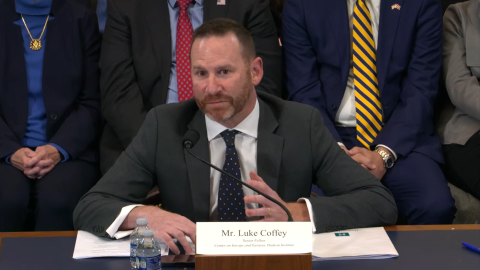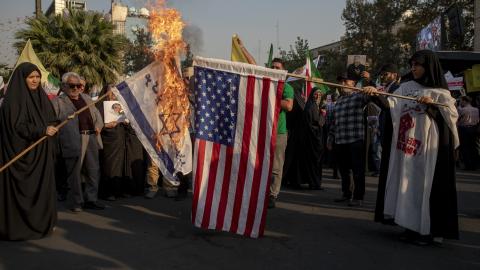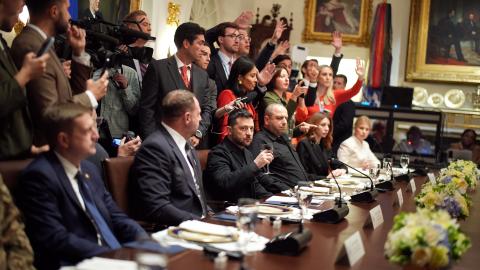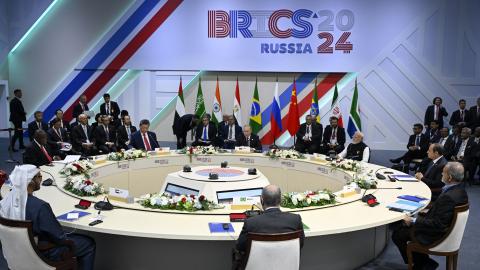In July 2025, President Donald Trump told his cabinet, “BRICS was set up to hurt us, BRICS was set up to degenerate our dollar and take our dollar . . . off as the standard.” His blunt warning captured a growing concern for the United States: that BRICS—once a loose grouping of developing markets that included Brazil, Russia, India, China, and South Africa—has in recent years expanded aggressively to challenge Western-led institutions and erode US financial primacy. The essential question is how effective an instrument BRICS will be.
It is important to note that the creation of BRICS was not random or unprecedented. The bloc represents the accumulation of sentiments that date back to the Cold War and postcolonial struggles. The Non-Aligned Movement, launched in Belgrade in 1961, gave an institutional form to newly independent states’ desire to escape the binary choice of alignment with the United States or the Soviet Union. But neutrality took on multiple meanings. A neutrality for sought genuine independence, as exemplified by Jawaharlal Nehru’s India and Josip Broz Tito’s Yugoslavia. These states prioritized sovereignty and freedom of maneuver. On the other hand, a neutrality against was less about independence and more about indirect opposition to the United States. Many governments in the 1970s claimed to be nonaligned while relying on Soviet patronage.
These currents persisted through the debt crises of the 1980s, the collapse of the Soviet Union in 1991, and the unipolar moment of the mid-1990s. In the early 2000s, China gave new life to the movement, presenting itself as the champion of the developing world, expanding ties with Africa, Asia, and Latin America, and emphasizing multipolarity as an alternative to Western financial dominance. The persistence of dollar centrality and the unequal distribution of influence within global institutions gave this narrative wider appeal, allowing BRICS to become the institutional expression of these accumulated grievances.
Russia, scarred by the turbulence of the 1990s, embraced BRICS as a framework of resistance. Its role fits squarely within the tradition of neutrality against, where so-called nonalignment takes the form of opposition to the United States—particularly after Washington levied sanctions against Moscow in 2014 and again in 2022. The creation of the BRICS New Development Bank in 2014, the spread of bilateral currency swap agreements, and the gradual promotion of yuan-denominated trade are all instruments designed to erode dollar centrality while presenting the project as reformist rather than revolutionary.
Brazil has approached these currents with greater flexibility. Its diplomacy continues to demonstrate neutrality for, seeking to gain leverage in the international system without breaking ties to Washington or Brussels. India, which played a founding role in the Non-Aligned Movement, continues to value autonomy. Its rivalry with China, sharpened by the 2020 Ladakh clashes, limits its willingness to accept structures that would expand Beijing’s influence, despite New Delhi’s investment in the BRICS framework.
The BRICS financial agenda, focused on promoting non-dollar trade, diversifying reserves, and building parallel institutions, turns the long-standing sentiment of nonalignment into a material threat to US interests. Since the creation of the Bretton Woods system in 1944, dollar primacy has served as the foundation of American global power. BRICS lacks the cohesion to displace the dollar outright. But it can provide political cover and institutional form to neutrality against. In doing so, it undermines the legitimacy of the dollar and the US-led world order.
The BRICS Financial Agenda
America’s global economic power rests mainly on the centrality of the dollar and the dominance of the Society for Worldwide Interbank Financial Telecommunication (SWIFT) network. SWIFT is a secure messaging system that links banks worldwide, giving Washington visibility into financial flows and enabling US agencies to enforce sanctions, combat money laundering, and disrupt terrorist financing.
This transparency is what distinguishes the dollar-based global system from older, informal frameworks. Hawala, a method of exchanging value without physically transporting gold or silver that emerged in South Asia in the eighth century, demonstrates the opposite model. Hawala relied on trust-based networks of brokers that operated without centralized records or supervision, leaving minimal documentation. This opacity made hawala resilient against enforcement and vulnerable to abuse. After the September 11 terror attacks, US officials identified it as a significant channel for terrorism funding and organized crime.
BRICS hopes to establish financial channels that are resistant to external monitoring and control, much like terrorist cells did with hawala. And like the hawala network, BRICS members are promoting local currency settlements and implementing alternative payment systems. But whereas hawala relies on informal networks, BRICS aims to foster official coordination among major economies to establish robust alternatives to the dominant reserve currency.
America’s control of the dollar and SWIFT form the cornerstone of America’s financial statecraft. In earlier decades, those seeking to avoid US scrutiny relied on informal methods, such as hawala or barter trade, which remained limited in scope and could not rival the liquidity or trust associated with the dollar. The new development is the shift from these marginal workarounds to formal institutions. BRICS initiatives such as the New Development Bank, China’s Cross-Border Interbank Payment System, and expanding currency swap arrangements represent coordinated attempts to build alternatives to dollar settlement. This institutionalization is significant because it shifts the challenge from the periphery to the center of global finance.
Washington’s ability to restrict access to SWIFT, demonstrated in sanctions against Iran in 2012 and Russia in 2022, is one of its most effective economic weapons. Hostile states, therefore, search for alternatives that do not leave their financial sovereignty at America’s discretion.
In fact, upon Moscow’s 2014 invasion of Crimea, the US threatened to cut Russia’s access to the SWIFT network. Russia responded by building the System for Transfer of Financial Messages (SPFS), which mimicked many of SWIFT’s features. But the system failed to gain traction because few states were willing to hold rubles instead of dollars.
Today, BRICS aims to go beyond Russia’s failed operation. Members are now debating new ways to erode the dollar’s dominance. If BRICS were to create a stable and widely accepted currency, the impact on US power would be profound. It would (a) damage America’s longstanding ability to enforce sanctions and control global financial flows and (b) weaken some of America’s most powerful diplomatic tools. Such moves amount to a reallocation of financial authority, reducing Washington’s ability to dictate the terms of global transactions. BRICS members still depend on the dollar’s liquidity and stability, but each summit strengthens the credibility of alternatives as de-dollarization shifts from aspiration to policy.
Bloc members have put forth several potential options to replace the dollar.
- Alternate national currency. Some BRICS members—namely China—hope to see more trade conducted in their national currencies. Beijing uses bilateral swap agreements and its own SWIFT alternative, the Cross-Border Interbank Payment System (CIPS), to expand the yuan’s reach. Since the West tightened sanctions on Russia, Moscow and Beijing have settled a growing share of their bilateral trade in yuan and rubles, while India has experimented with rupee-based trade. The results remain modest. The yuan accounts for only 2 to 3 percent of global transactions, according to SWIFT data. Beijing’s capital controls and the Chinese central bank’s convertibility restrictions continue to hinder the yuan’s practicality as a reserve currency.
- Barter and clearing arrangements. Some BRICS members have already used such frameworks. India and Russia have conducted rupee-ruble trade, and Iran has long relied on barter deals to compensate for its shortages of hard currency. These systems can serve as a lifeline for sanctioned states or countries in crisis. But they are difficult to balance or scale, and can break down in multilateral exchanges. At best, they are stopgaps rather than durable alternatives to the dollar.
- Digital currencies. The most disruptive scenario involves cryptocurrency-based exchange systems. Cryptocurrencies, particularly stablecoins, already function as a shadow banking system in financially fragile or heavily sanctioned states such as Venezuela or Iran. Pegged to the US dollar, stablecoins like USDT and USDC serve as a convenient store of value, enabling quick and low-cost cross-border transfers. Yet their relationship to American power is more complicated: while these stablecoins compete with US financial institutions and serve as workarounds to US oversight, they simultaneously reinforce the dollar’s primacy by extending its digital reach. A coordinated BRICS initiative would aim to escape this dependence on the dollar altogether. China has piloted its digital yuan, and Russia has promoted crypto-friendly policies. But internal divergences within BRICS, Beijing’s restrictions on domestic cryptocurrency use, and the volatility of non-stablecoin tokens have so far prevented BRICS from creating a joint system. The bloc has discussed the creation of a digital currency platform called BRICS Pay to handle cross-border transactions in local currencies. But the project remains embryonic.
A Second Front for BRICS: The Gulf
BRICS has focused on the Gulf as a battleground to challenge the monetary dominance that has anchored American influence since the 1970s.
China leads this challenge by pushing Gulf oil producers to settle portions of their sales in yuan. Meanwhile, Huawei’s role in shaping regional telecom standards could enable China to establish alternative payment and data pathways to skirt Western oversight. And Beijing has encouraged sovereign wealth funds in Abu Dhabi, Riyadh, and Doha to invest in yuan-denominated platforms, digital currencies, and blockchain-based trade systems.
Russia and Iran are also undermining the dominance of the dollar in the region. For instance, Russia conducts arms, energy, and capital transactions with Iran in rubles and Iranian rials, reducing exposure to US sanctions. Iran, for its part, sustains its economy through barter arrangements, gold transfers, and cryptocurrency networks that bypass conventional banking channels. Together, these parallel financial systems demonstrate to potential BRICS partners that commerce can persist outside the dollar system, even under heavy US pressure.
Through these initiatives, BRICS nations aim to reduce the Gulf’s dependence on the dollar and weaken the reach of US sanctions under the guise of hedging against Western economic coercion.
BRICS is also increasing its influence and legitimacy through formal partnerships with the Gulf. The United Arab Emirates, a close American security partner and a critical financial hub, joined BRICS in 2023. This decision does not signal a total break in US-UAE relations. But it reflects Abu Dhabi’s calculation that BRICS membership offers tangible benefits at a minimal cost. Riyadh has made a similar calculus. Although Saudi Arabia has not formally joined the organization, it has hedged its bets by attending summits, discussing yuan-denominated oil sales, and establishing investment frameworks with China.
Riyadh’s and Abu Dhabi’s overtures toward BRICS increase the bloc’s legitimacy and demonstrate that membership and engagement are compatible with continued US security partners. This makes it more difficult for Washington to frame the bloc as either (a) marginal and ineffective or (b) anti-Western and hostile. By drawing Gulf allies into the BRICS orbit, Beijing and Moscow have begun to erode the central narrative of the American-led financial order: that US partners will remain loyal because the current system offers them the most benefits.
If Washington fails to respond effectively, the Gulf could become a laboratory for BRICS-backed financial alternatives—with Washington’s traditional partners serving as the test subjects of a new, parallel economic order.
Recommendations
American policymakers have begun to recognize the risk of parallel financial institutions. President Trump’s signing of the Guiding and Establishing National Innovation for US Stablecoins (GENIUS) Act laid the foundation for oversight mechanisms that combat the use of stablecoins in sanctions evasion. But domestic regulation alone is insufficient. The pace of financial innovation is too rapid, and the incentives for BRICS states to pursue financial sovereignty are too strong. They are unlikely to abandon the search for digital and political alternatives.
To sustain the dollar’s status—and therefore Washington’s ability to conduct global financial oversight—the US will need to adopt a combination of economic, regulatory, and diplomatic measures.
- Prohibit dual participation. Any financial institution that chooses to operate within a clearing system designed to bypass SWIFT should lose access to both SWIFT and dollar-denominated transactions. The calculation for banks would be straightforward. Losing access to the US system, which still processes almost all global transactions, would be far more damaging than gaining access to any parallel network that BRICS offers.
- Strengthen oversight of stablecoins. Some of these digital instruments are dollar-denominated, which reinforces demand for the dollar. But others are opaque and designed for illicit use. US policymakers should ensure that stablecoins do not become tools to evade sanctions or oversight. The GENIUS Act laid a strong foundation for stablecoin regulation; however, additional measures will be required as technology evolves and BRICS states experiment with new digital assets.
- Apply sustained diplomatic and economic pressure. Washington should remind countries considering accession to BRICS of the costs of aligning with a project designed to weaken the United States. Existing members should be discouraged from participating in Russian, Chinese, or Iranian efforts to erode the dollar’s role. The US should couple these warnings with the offer of alternatives: US and allied investment, infrastructure assistance, and financing arrangements that ensure partnership with Washington remains more attractive than betting on a parallel order.
Conclusion
The dollar has long been among America’s most powerful strategic assets. Preserving the dollar’s centrality helps sustain US oversight of global transactions and Washington’s ability to enforce rules against drug cartels, terrorist organizations, and other transnational threats. It is also a key diplomatic tool in the current great power rivalry.
BRICS threatens to chip away at the dollar’s dominance by creating opaque, unregulated channels for trade and finance. Unless Washington acts decisively to defend SWIFT, regulate stablecoins, apply diplomatic pressure, and reinforce the legitimacy of US global financial oversight, BRICS will continue to construct an anti-US financial order while presenting itself as the champion of neutral nonalignment and multipolarity.
